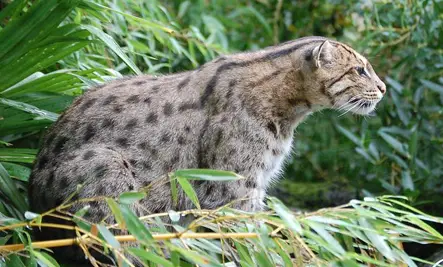Of the 41 species of cats living in the world today, there are seven species that stand out as being extraordinarily rare.
Some of these wild cat species are naturally solitary and secretive, so they have been rare as long as they have existed. Others used to have giant and robust populations, but have been pushed back by the wake of human activity. Each of these species may have fewer than 4,000 individuals living in the wild—and their habitats and food sources are shrinking daily. As such, all of these rare cats’ populations are now declining.
What can you do? For a start, you can learn about them and understand how their plight came to be. Of the seven rarest species of wild cats, six species are Endangered, while one species is considered Critically Endangered. Only a few of them are widely known. Which of these majestic, threatened creatures did you already know?
7. Snow Leopard (Uncia uncia) — above
Snow leopards live in the mountains of Central Asia, at altitudes of 10,990 to 22,000 ft (3,350 to 6,700 meters). Their paws are wide, like snowshoes, which helps them walk across the snow, and they have fur on the bottoms of their paws to help them grip steep, slippery surfaces. Their biggest threats are insufficient prey (due to humans’ illegal hunting of their prey), poaching, and conflict with local people. There are an estimated 4,080 to 6,590 individuals in the wild, but fewer than 2,500 of these are likely or able to reproduce.
6. Fishing Cat (Prionailurus viverrinus)
Fishing cats live in wetlands in parts of South and Southeast Asia, especially near streams, rivers, and mangrove swamps. They have webbed paws, and are adept at catching fish and other small prey. Their IUCN status is Endangered, as their wetland habitats are increasingly being settled or converted into agricultural land.
5. Tiger (Panthera tigris)
Tigers are the largest cat species in the world; while they used to live throughout much of Asia, they have lost over 93% of their historic range. Their current range is extremely fragmented, covering parts of India, China, Southeast Asia, and Siberia; there are only an estimated 3,062 to 3,948 individuals left in the wild. Four of the six extant subspecies of tigers are listed as Endangered, one subspecies is Critically Endangered, and one subspecies (the South China tiger) is actually Extinct in the Wild.
4. Borneo Bay Cat (Pardofelis badia)
Borneo bay cats are nocturnal and very secretive, and they live only on the island of Borneo. They have traditionally been a rarer animal, even in pristine habitats, but because of extensive deforestation, their already-sparse population is projected to decline 20% by the year 2020. There are likely less than 2,500 mature individuals in the wild, and there are currently no bay cats in captivity.
3. Flat-headed Cat (Prionailurus planiceps)
Flat-headed cats live in lowland forest wetlands in the Thai-Malay Peninsula, Borneo and Sumatra. Their nose is very long and sloping, and their skull is flattened, hence their name. They are solitary, nocturnal creatures, who hunt fish, frogs, and crustaceans. They have even been observed washing objects in the water, similar to how a raccoon would!
Like the fishing cat (their close relative), flat-headed cats’ reliance on wetlands leaves them especially vulnerable, as these habitats are frequently converted or destroyed. There may be fewer than 2,500 flat-headed cats left in the world.
2. Andean Cat (Leopardus jacobita)
Andean cats are the small cat equivalent of the snow leopard: they live well above the tree line, at elevations of 11,500–15,700 feet (3,500–4,800 meters), wherever there is enough water to support them. They occur in the Andes Mountains in Argentina, Bolivia, Chile, and Peru. Prior to 1998, they had only ever been photographed twice!
Like the Borneo bay cat, they seem to have a naturally low population density—not because they are territorial, but because individual Andean cats seem to have amazingly large home ranges. However, habitat loss and degradation (e.g. from mining) are turning this species from a rare-but-stable population to an endangered-and-decreasing population.
1. Iberian Lynx (Lynx pardinus)
Iberian lynxes are the only cat species to be considered Critically Endangered (IUCN’s highest risk category); as of 2005, there may be only 100 Iberian lynxes left in the wild. They live in 2-3 isolated areas in southern Spain. One of the reasons they’re so endangered is because they have specialized eating habits: rabbits make up 80-100% of their diet, and as the rabbit populations have suffered from disease, over-hunting by humans, and habitat change, the Iberian lynxes have likewise dwindled.
